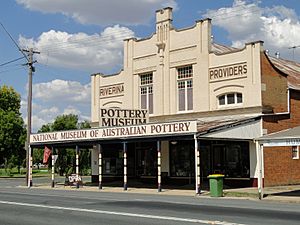National Museum of Australian Pottery facts for kids

National Museum of Australian Pottery, Holbrook
|
|
| Established | 1995 |
|---|---|
| Location | Holbrook, New South Wales |
The National Museum of Australian Pottery is a special place. It is located in Holbrook, New South Wales. This museum shows off more than 2,000 pieces of old Australian pottery. These items were used in homes during the 1800s and early 1900s.
Contents
Discover Australian Pottery
The museum's collection includes pottery from over 130 different Australian makers. You can see many interesting items here. These include teapots, jugs, and water filters. There are also old ginger beer bottles. Many pieces are colorful and decorative.
The Convict Potter
One very important potter featured is Jonathon Leak. He was a convict who lived from 1777 to 1838. His pottery pieces are the oldest marked Australian pottery ever found. Many of Leak's items on display were found in a clay pit in Sydney. This happened during an archaeological dig in 2007.
History of the Museum
The National Museum of Australian Pottery first opened its doors in 1995. It was originally located in Wodonga, Victoria. In 2006, the museum moved to its current home in Holbrook.
The Museum Building
The building where the museum is now located has its own history. It was built in 1910. Back then, it was a large department store. It belonged to a company called A. H. Mackie and Company.
The Founders
The museum is owned and run by Geoff and Kerrie Ford. They have done a lot for Australian pottery. They even received the Order of Australia Medal. This award was given for their "service to the arts." It also recognized their work in studying early Australian pottery. Geoff Ford has written several books about Australian pottery. These include Australian Pottery: The first 100 years (1995). He also wrote the Encyclopaedia of Australian Potter's Marks (1998). Another book is Convict Potters of Australia 1821 to 1851 (2001).
Special Exhibitions
The National Museum of Australian Pottery also has changing exhibitions. These are short-term displays. They often show different themes or types of pottery. This means there is always something new to see.

